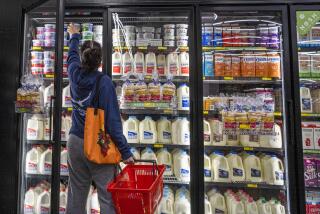Leading Indicators Index Rises
- Share via
WASHINGTON — A key gauge of future U.S. economic growth rose for the third straight month in December, suggesting a strong start to 2006, but a private research group said Monday that growth could become choppy as the year progresses.
The U.S. index of leading indicators rose 0.1% in December to 138.5, just below market expectations for a 0.2% rise, the Conference Board said. December’s increase built on an upwardly revised 0.9% advance in November.
“The indicators may be signaling a spurt of growth ahead, perhaps in the spring, which could be followed by a slower pace of activity later in 2006,” Ken Goldstein, labor economist at the Conference Board, said in a statement.
Analysts said the large upward revision to November data more than offset the slightly lower-than-expected gain in December. November’s rise was first reported as a 0.5% increase.
Ian Shepherdson, chief U.S. economist at High Frequency Economics, said the report also proved the economy had shaken off the effects of Hurricane Katrina, which devastated the U.S. Gulf Coast in late August.
“The key point here is that the Katrina drop has been more than reversed: The index fell 0.7% in September, after the storm, but over the past three months it has risen 1.9%,” Shepherdson said. “We expect another 0.5% rise in January, signaling a very strong start to the year.”
The coincident index, a barometer of current economic activity, increased 0.2% in December after rising 0.4% in November. The lagging index climbed 0.1% last month after November’s 0.5% advance.
Goldstein said the behavior of the three indexes suggested a “quite choppy pattern of growth” in the months ahead.
“Improvement in the leading series, steady modest gains in the coincident series, a recent pickup in the lagging series and a flat to declining trend in the ratio of coincident to lagging series is not the mix of indicators one would expect if 2006 is to be a year of steadily building momentum,” he said.
The leading index measures a basket of economic indicators including unemployment benefit claims and building permits. It is supposed to forecast economic trends as much as six months ahead.
Six of its 10 components strengthened in December. The positive contributors included consumer expectations, real money supply and stock prices.
The negative contributors were vendor performance, new orders for non-defense capital goods, building permits and average weekly factory hours.
More to Read
Inside the business of entertainment
The Wide Shot brings you news, analysis and insights on everything from streaming wars to production — and what it all means for the future.
You may occasionally receive promotional content from the Los Angeles Times.










